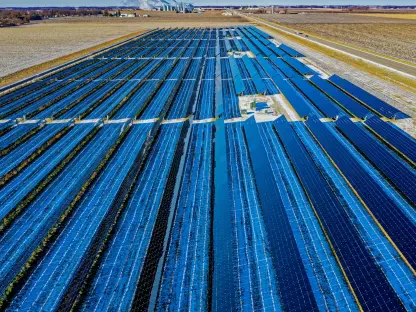The utility-scale grid-connected microgrid market is experiencing unparalleled growth, driven by the increasing integration of renewable energy sources, grid modernization initiatives, and the emergent need for enhanced energy resilience. As of 2023, this burgeoning sector was valued at $1.5 billion, with projections estimating a substantial rise to $8.3 billion by 2032. This article delves into the various aspects fueling this market’s rapid expansion and the potential it holds for the future.
Understanding Utility-Scale Grid-Connected Microgrids
Utility-scale grid-connected microgrids are sophisticated energy systems designed to operate both autonomously and synergistically with conventional power grids. They typically integrate renewable energy sources such as solar and wind, paired with energy storage solutions to ensure a reliable power supply for large-scale facilities, communities, or utilities. These microgrids play a crucial role in enhancing grid stability, bolstering energy resilience, and reducing reliance on traditional fossil fuels. Moreover, they support the incorporation of clean energy into the power grid, greatly contributing to global decarbonization efforts.
In an era where the demand for uninterrupted and cleaner power is escalating, utility-scale grid-connected microgrids offer a viable solution. Their ability to operate independently in the event of a grid failure makes them indispensable in regions prone to natural disasters or grid instability. The flexibility to seamlessly integrate with the main power grid during normal operations further underlines their importance.
Market Drivers
Demand for Uninterrupted Power Supply
The increasing frequency and intensity of natural disasters, coupled with aging grid infrastructures, heighten the need for continuous power supply solutions. Regions prone to extreme weather conditions or grid inconsistencies are pivoting towards microgrid solutions to ensure a steady and reliable energy supply. This demand is more pronounced in areas where traditional power infrastructures are struggling to keep pace with rising energy needs.
The ability of microgrids to provide localized, resilient power during outages makes them an attractive investment for utilities and governments alike. This shift towards ensuring energy resilience is a significant catalyst in the growing adoption of microgrids globally.
Grid Modernization and Flexibility
As the global push towards renewable energy gains momentum, the need for modern, flexible grid systems has never been clearer. Governments and utilities are channeling major investments into upgrading existing grid infrastructures to enhance their resilience, flexibility, and operational efficiency. Microgrids are central to these grid modernization efforts, as they enable the seamless integration of renewable energy sources while reducing carbon footprints.
By supporting distributed generation and two-way power flows, microgrids add a layer of dynamism to traditional grids. This flexibility is vital for accommodating the intermittent nature of renewable energy and for optimizing energy distribution.
Technological Advancements
The continuous advancements in microgrid components, ranging from sophisticated inverters to advanced energy management systems, are pivotal in enhancing the efficiency and reliability of microgrids. Real-time monitoring and control systems have become more prevalent, ensuring optimal performance and quick responses to grid fluctuations. These technological innovations are instrumental in making microgrids a more attractive and practical option for utilities and large-scale energy consumers.
Additionally, the integration of digital technologies like AI and IoT in microgrid systems facilitates predictive maintenance, real-time data analytics, and overall better decision-making for energy management. This technological edge is a critical driver for the market’s rapid growth.
Sustainability Goals and Government Support
Increasing global pressure on utilities to meet stringent sustainability targets and reduce carbon emissions is propelling the microgrid market forward. Supportive governmental policies and financial incentives play a crucial role in fostering this growth. Significant investments in research and development aimed at improving microgrid technologies and effectively integrating renewable energy sources are a testament to this support.
Governments worldwide are recognizing the potential of microgrids to achieve energy transition goals. Policies promoting renewable energy integration and grid modernization, combined with financial incentives for adopting clean energy technologies, are pivotal in driving market expansion.
Market Segmentation
Power Sources
Microgrids are powered by a variety of sources, each with unique advantages and applications. Diesel generators, renowned for their reliability during grid outages, are projected to exceed $3 billion by 2032. Their lower initial investment and maintenance costs, coupled with ubiquitous fuel availability, ensure their continued demand.
Natural gas-powered microgrids are increasingly popular due to their lower carbon footprint compared to diesel. Solar PV microgrids are also on the rise, thanks to advancements in solar technology and its cost-effectiveness, especially in sunny regions. Combined Heat and Power (CHP) systems offer enhanced efficiency by utilizing waste heat for additional power generation. Other emerging renewable sources and technologies continue to enrich the microgrid landscape.
Storage Devices
Energy storage is a critical component of microgrids, ensuring a steady power supply and enhancing system efficiency. Lithium-ion batteries dominate the market due to their high energy density, fast response times, and declining costs. Lead-acid batteries, although older technology, remain in use for their reliability and lower costs in specific applications.
Flow batteries are gaining traction as a viable option for sustainable and scalable energy storage solutions. Their ability to provide long-duration storage and their inherent stability make them an attractive choice for microgrid applications. Other storage devices, including flywheels and ultracapacitors, are also contributing to the evolving landscape of microgrid storage solutions. Flywheels, in particular, are noted for their rapid response times and high durability, which are critical for maintaining grid stability and managing energy demand fluctuations.
Regional Analysis and Trends
Asia Pacific
Expected to hit $4.5 billion by 2032, the Asia Pacific region is witnessing rapid energy demand growth. Government initiatives to promote renewable energy adoption and significant investments in energy infrastructure, especially in developing economies, are driving market growth. The region’s susceptibility to natural disasters, necessitating resilient power generation and distribution systems, further augments the demand for microgrids.
North America
In the U.S., the adoption of advanced technologies such as energy storage, artificial intelligence (AI), and the Internet of Things (IoT) is propelling the microgrid market. Regulatory frameworks and economic benefits are fostering a shift towards decentralized energy systems. The integration of smart grid technologies enhances the overall efficiency and reliability of microgrids, making them an attractive solution for energy management.
Europe
Governments in Europe are actively supporting the transition to renewable energy systems through policies and incentives aimed at reducing carbon footprints. Countries like Germany, France, and the UK are at the forefront, investing substantially in microgrid deployments to enhance grid stability and support environmental goals.
Middle East and Africa
Regions such as Saudi Arabia and the UAE are investing in microgrid solutions to diversify their energy sources and reduce reliance on fossil fuels. The focus on developing sustainable infrastructure aligns with their long-term energy strategies.
Latin America
Countries like Brazil and Argentina are exploring microgrids as a means to address energy distribution challenges and harness abundant renewable resources. Investments in smart grid technologies and renewable energy projects are gradually transforming the energy landscape in the region.
Industrial Strategies and Key Players
Major players in the utility-scale grid-connected microgrid market include ABB, Black & Veatch, Dominion Energy, ESS Tech, Eaton Corporation, General Electric, Hitachi Energy, Honeywell, mtu Solutions, Schneider Electric, S&C Electric Company, and Team Sustain. These companies are forming strategic alliances with technology providers, research institutions, and government agencies to enhance their capabilities in microgrid solutions. Key strategies include:
Research and Development: Heavy investments are being made in R&D to improve energy storage systems, develop advanced control algorithms, and foster renewable energy integration. Digital technologies are being implemented to enhance monitoring, predictive maintenance, and real-time data analytics.
Smart Grid Integration: The adoption of smart grid technologies is facilitating efficient and reliable microgrid operations, enabling better decision-making for energy management. This integration is essential for optimizing energy use and enhancing grid resilience.
Strategic Alliances: Partnerships and collaborations among key players are driving forward the advancements and deployment of microgrid technology. These strategic alliances help in pooling expertise and resources, fostering innovation and more rapid market growth.
Recent Developments
Eaton and Enel Partnership: In April 2024, Eaton, in collaboration with Enel North America, launched a significant clean energy microgrid at its Arecibo, Puerto Rico facility. This project, the largest of its kind in Puerto Rico, aims to significantly reduce the facility’s carbon footprint, enhance energy resilience, and strengthen community infrastructure.
Dominion Energy’s U.S. Project: In March 2021, Dominion Energy secured a $47.9 million utility energy service contract to enhance energy resilience at Marine Corps Base Quantico. This project involves installing generators to support critical facilities through on-site microgrids during emergencies and refurbishing a microturbine system to reduce peak demand and electricity costs.
Conclusion
The utility-scale grid-connected microgrid market is witnessing unprecedented growth, primarily driven by the increasing adoption of renewable energy sources, efforts to modernize the grid, and a rising need for improved energy resilience. As of 2023, this fast-growing industry was valued at $1.5 billion, with forecasts predicting a remarkable increase to $8.3 billion by 2032. This significant growth can be attributed to several key factors.
First, the integration of renewable energy sources like solar and wind is playing a crucial role in driving this market forward. These sustainable energy options are becoming more viable and cost-effective, making them attractive for large-scale applications. Second, grid modernization initiatives are essential in supporting the efficient distribution and management of energy, incorporating advanced technologies to enhance overall functionality and reliability.
Lastly, the emergent need for enhanced energy resilience cannot be overlooked. With climate change and natural disasters posing increasing threats, the need for more robust and reliable energy systems is apparent. Microgrids offer a solution by providing localized energy generation and distribution, which can operate independently of the main grid in times of crisis. This article explores these various aspects that are fueling the rapid expansion of the utility-scale grid-connected microgrid market and the immense potential it holds for future advancements.









